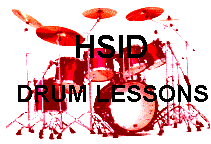|
Downloads *
Drummers Trivia *
Drummers Chat Rooms *
Rudiments *
Digital Music *
Knowledge Assessments *
TD Archives *
Drum Set Buyers Guide *
Bass-Player Jokes *
Assembling a Drum Set *
Parts of a Drum Set *
About HSID *
Video Troubleshooter
Bill Powelson's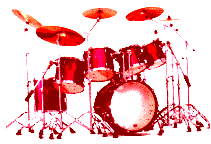 School of Drums
School of Drums
PRIVATE DRUM LESSON 10 E-M
"Reggae & Ska"
Copyright 1998 Bill Powelson all rights reserved

REGGAE & SKA
I am still searching for verified histories of these two beat patterns. Meanwhile, I'll just pass along what I have picked up over the years. Legend has it that Ska came first from Europe during the early days of the British rock and pop invasions of the 1960s. Actually, classic Reggae and Ska are based on the
same general beat patterns. Some have theorized that both movements were the
result of a drummer with a coordination problem. The classic forms of these two
patterns are based in 8th-note 4/4 rock. The only difference being that with Ska/Reggae we alter the 8th rock beat, eliminating all cymbal notes that fall on the number count. Put another way, the drummer alters the 8th rock beat in such a way that the hi-hat or ride cymbal is played only on the 'and' or in-between the counts. As the drummer emphasizes this 'different' sounding rhythm . . . the guitarists and other instruments tend to accent along with the drummer on the 'and'. This lays the foundation for all the unique and interesting rhythm patterns that are the basis of both Reggae and Ska. Ska generally tends to often be a little faster in tempo than Reggae.
SIMPLE Reggae or Ska
This first beat (below) is the simplest or most basic form. Since this most basic form is so simple, it is easy to jump-in playing it too fast. Later, as you begin to inject variations and syncs to this rhythm it will become increasingly difficult to maintain those rapid tempos. It is best to take it extremely slow until total mastery with variations and syncopations begins to occur. Resist playing this rhythm a blinding speeds in the early stages.
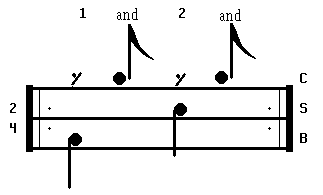
 Hear the way Ska/Reggae will sound. Listen closely to the cymbal rhythm. It is very difficult to hear it. The cymbal is only being played in-between the number counts or on the 'and' of, 1 and 2 and as the beat repeats. Hear the way Ska/Reggae will sound. Listen closely to the cymbal rhythm. It is very difficult to hear it. The cymbal is only being played in-between the number counts or on the 'and' of, 1 and 2 and as the beat repeats.
 Compare a bar of 8th rock
to bar of Reggae or Ska. Visually notice, then listen for the similarities between these two beats! It may be difficult to distinguish the difference when listening to these midi files but there is a distinct difference in the cymbal line. Blame the midi files if you can't hear a difference. :>) Compare a bar of 8th rock
to bar of Reggae or Ska. Visually notice, then listen for the similarities between these two beats! It may be difficult to distinguish the difference when listening to these midi files but there is a distinct difference in the cymbal line. Blame the midi files if you can't hear a difference. :>)
(These patterns are written in 2/4 for simplicity. We normally write them in 4/4.)
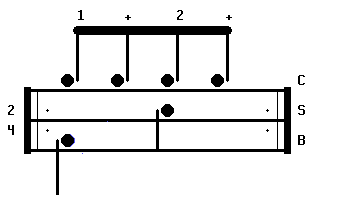
It would be easy to fill several books with variations of this style of playing. But, I'm not sure this would be the best way to progress. It seems the learning curve is greatly
accelerated by simply jamming and improvising with this basic concept.
Begin with the basic Reggae (or Ska) pattern above, then try playing all of your
routine 8th rock variations and syncs while maintaining this same somewhat spastic cymbal pattern.
I'll toss in a few 4/4 variations to get you started. You will quickly discover many more
as you play along with your favorite Ska and Reggae recordings. Permutation
theory will prove that 4.3 Billion possibilities exist here . . . it's the same as
normal 8th rock. Give up on trying to learn them all. Just listen and jam with all
your favorite music in this framework. The most important rhythmic possibilities should
surface as you listen and play.
The following examples are written in 4/4.
A. 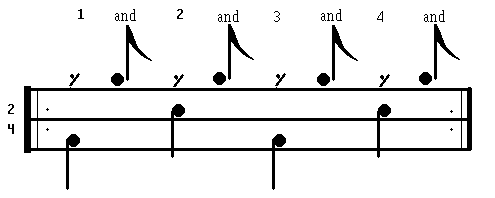
 Pay close attention to the
cymbal as you practice these. The trick is to play all of your routine rock
variations and syncs while maintaining the unique 'and' only cymbal. Pay close attention to the
cymbal as you practice these. The trick is to play all of your routine rock
variations and syncs while maintaining the unique 'and' only cymbal.
B. 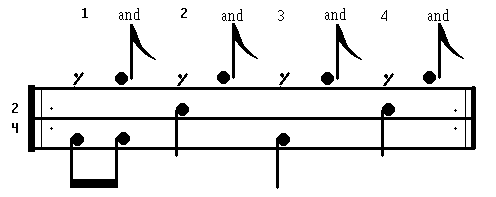
 Nobody said it would be easy!
It's like learning all over again!
C. Nobody said it would be easy!
It's like learning all over again!
C. 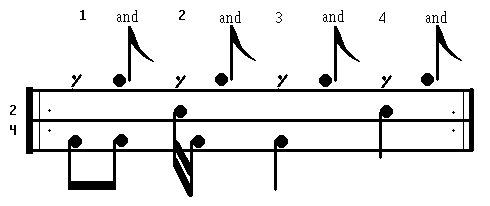
 It will grow on you slowly!
After mastering a handful of these patterns, the right (cymbal) hand will develop
a mind of its own. Once you become accustomed to playing the cymbal on the 'and', it will gradually become a habit to maintain the odd cymbal pattern. Later, variations and syncs will come much easier than these first few. It will grow on you slowly!
After mastering a handful of these patterns, the right (cymbal) hand will develop
a mind of its own. Once you become accustomed to playing the cymbal on the 'and', it will gradually become a habit to maintain the odd cymbal pattern. Later, variations and syncs will come much easier than these first few.
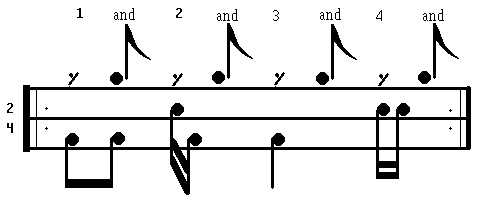
 Are you getting the idea?
Get out a pen and scrap of paper. Write some interesting possibilities of your own,
then try to play them. Are you getting the idea?
Get out a pen and scrap of paper. Write some interesting possibilities of your own,
then try to play them.
 To finish this lesson,
Here is a string of Ska/Reggae variations and syncs played back to back. To finish this lesson,
Here is a string of Ska/Reggae variations and syncs played back to back.
 VIDEO: Click here to 'Play', see, and hear everything in this lesson, at a moderate tempo. VIDEO: Click here to 'Play', see, and hear everything in this lesson, at a moderate tempo.
You will need to 'live' and 'love' this music style to master playing it! Order up a new batch of Reggae or Ska CDs and get into it!

Copyright Bill Powelson 1996 all rights reserved.
| 

